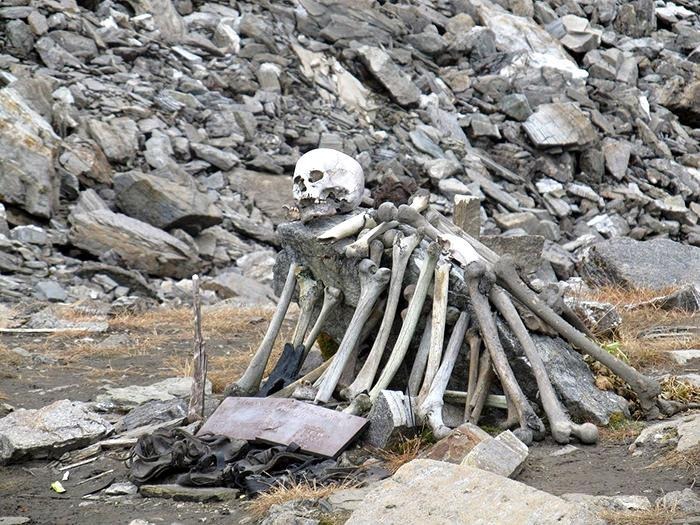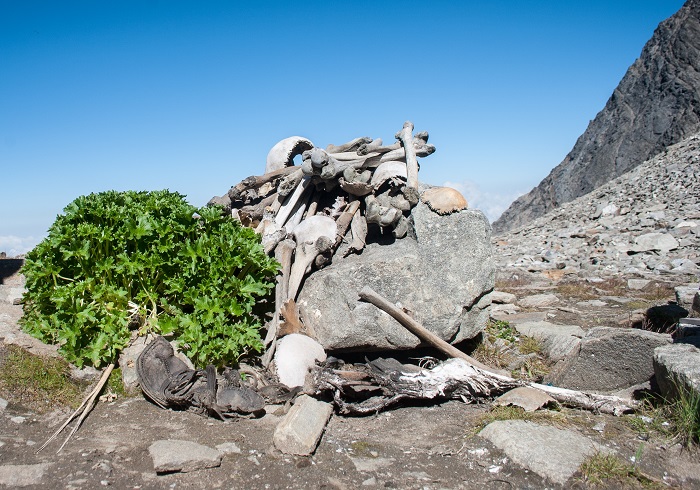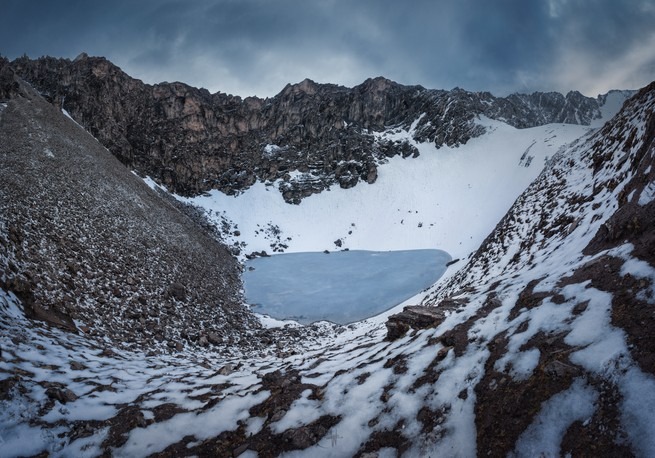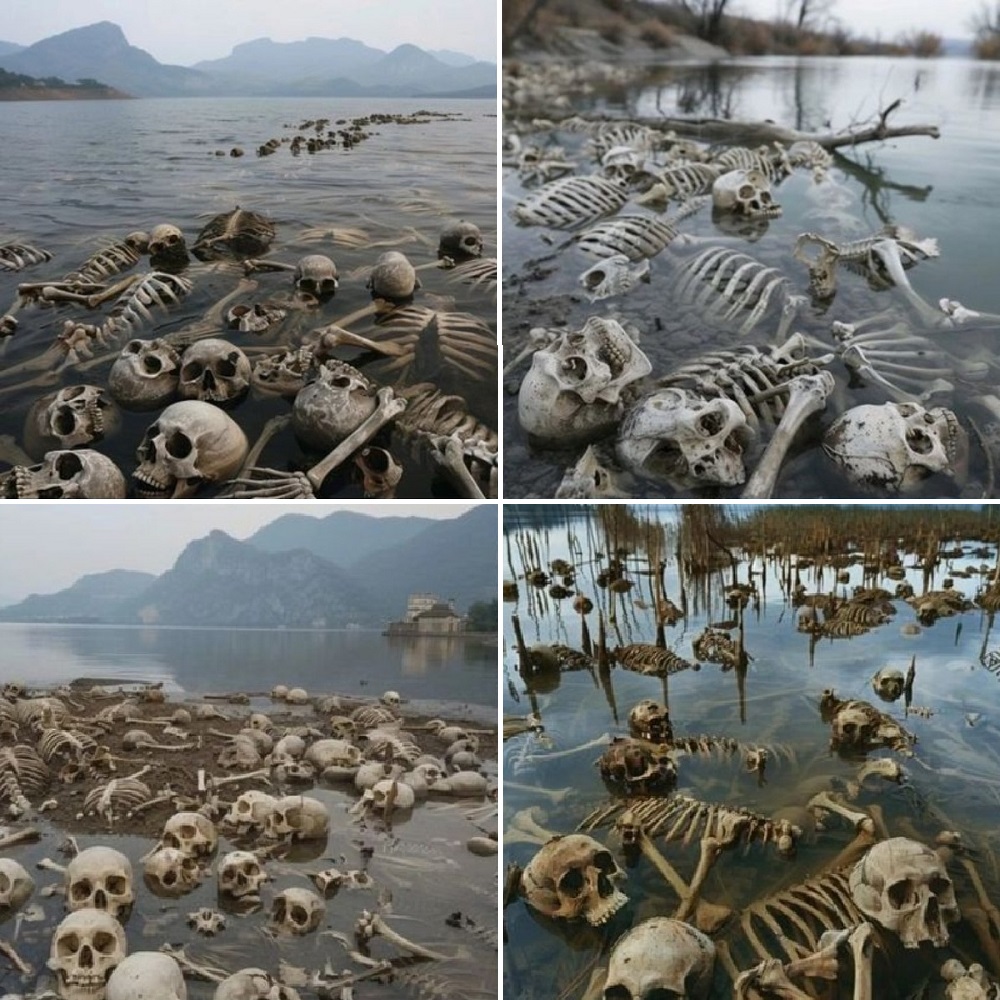Hundreds of skeletons are scattered around a site high in the Himalayas, and a new study overturns a leading theory about how they got there.
Skeletal remains from as many as 500 people might lie in and around Roopkund lake. (Awanish Tirkey / Shutterstock)
In a kinder world, archaeologists would study only formal cemeteries, carefully planned and undisturbed. No landslides would have scattered the remains. No passersby would have taken them home as souvenirs, or stacked them into cairns, or made off with the best of the artifacts. And all this certainly wouldn’t be happening far from any evidence of human habitation, under the surface of a frozen glacial lake.

But such an ideal burial ground wouldn’t have the eerie appeal of Skeleton Lake in Uttarakhand, India, where researchers suspect the bones of as many as 500 people lie. The lake, which is formally known as Roopkund, is miles above sea level in the Himalayas and sits along the route of the Nanda Devi Raj Jat, a famous festival and pilgrimage. Bones are scattered throughout the site: Not a single skeleton found so far is intact.
Since a forest ranger stumbled across the ghostly scene during World War II, explanations for why hundreds of people died there have abounded. These unfortunates were invading Japanese soldiers; they were an Indian army returning from war; they were a king and his party of dancers, struck down by a righteous deity. A few years ago, a group of archaeologists suggested, after inspecting the bones and dating the carbon within them, that the dead were travelers caught in a lethal hailstorm around the ninth century.
In a new study published today in Nature Communications, an international team of more than two dozen archaeologists, geneticists, and other specialists dated and analyzed the DNA from the bones of 37 individuals found at Roopkund. They were able to suss out new details about these people, but if anything, their findings make the story of this place even more complex. The team determined that the majority of the deceased indeed died 1,000 or so years ago, but not simultaneously. And a few died much more recently, likely in the early 1800s. Stranger still, the skeletons’ genetic makeup is more typical of Mediterranean heritage than South Asian.

“It may be even more of a mystery than before,” says David Reich, a geneticist at Harvard and one of the senior authors of the new paper. “It was unbelievable, because the type of ancestry we find in about a third of the individuals is so unusual for this part of the world.”
Roopkund is the sort of place archaeologists call “problematic” and “extremely disturbed.” Mountaineers have moved and removed the bones and, researchers suspect, most of the valuable artifacts. Landslides probably scattered the skeletons, too. Miriam Stark, an archaeologist at the University of Hawaii at Manoa who was not involved in the research, pointed out that, unlike most archaeological sites, Roopkund is “not within a cultural context,” like a religious site or even a battlefield. That makes the new study “a really useful case study of how much information you can milk” from an imperfect data set, she says.
From a scientific standpoint, the only convenient thing about Roopkund is its frigid environment, which preserved not only the bones, but the DNA inside them, and even, in some cases, bits of clothing and flesh. That same environment can make the site difficult to study. Veena Mushrif-Tripathy, an archaeologist at Deccan College in Pune, India, was part of an expedition to Roopkund in 2003. She says that even at base camp, which was about 2,300 feet below the lake, the weather was dangerous and turned quickly. To reach Roopkund, the party had to climb to a ridge above the lake and then slide down to it, because the slopes surrounding the lake are so steep.

Atish Waghwase
Mushrif-Tripathy never actually reached the lake; she was stuck at base camp with altitude sickness. “That was one of my biggest … regrets,” she says. “Still today, I am not over that.”
As Fernando Racimo, a geneticist at the University of Copenhagen, points out, ancient-DNA studies commonly focus on the global movements of human populations over thousands of years. The new study, in contrast, is “a nice example of how ancient-DNA studies could not only inform us about major migration events,” Racimo says, “but it can also tell smaller stories that would have not been possible to elucidate otherwise.” Stark says that seeing geneticists and archaeologists collaborating to ask nuanced questions is refreshing. “A lot of the time it seems like the geneticists are just performing a service,” she says, to prove the hunches of anthropologists or historical linguists about where a specimen really came from. “And that’s not what we should be asking.”

To Kathleen Morrison, the chair of the anthropology department at the University of Pennsylvania, the least interesting thing about the specimens at Roopkund is where in the world their DNA says they came from. She points out that a Hellenic kingdom existed in the Indian subcontinent for about 200 years, beginning in 180 B.C. “The fact that there’s some unknown group of Mediterranean European people is not really a big revelation,” she says. She also cautions that radiocarbon dating gets less and less accurate the closer specimens get to the present day, so the early-1800s date assigned to the Roopkund specimens with Mediterranean heritage might not be perfectly accurate.
Besides, knowing that some of the bones at Roopkund came from a slightly unusual population still doesn’t shake the fundamental mystery: how hundreds of people’s remains ended up at one remote mountain lake. Reich and Mushrif-Tripathy are both confident that the skeletons were not moved to the site. Mushrif-Tripathy believes that the people whose bones she helped study simply “lost their way” and “got stuck” near the lake during bad weather. As Reich points out, it’s possible that remains scattered around the area gradually fell into the lake during landslides.
Morrison, though, doesn’t fully buy this explanation. “I suspect that they’re aggregated there, that local people put them in the lake,” she says. “When you see a lot of human skeletons, usually it’s a graveyard.”

